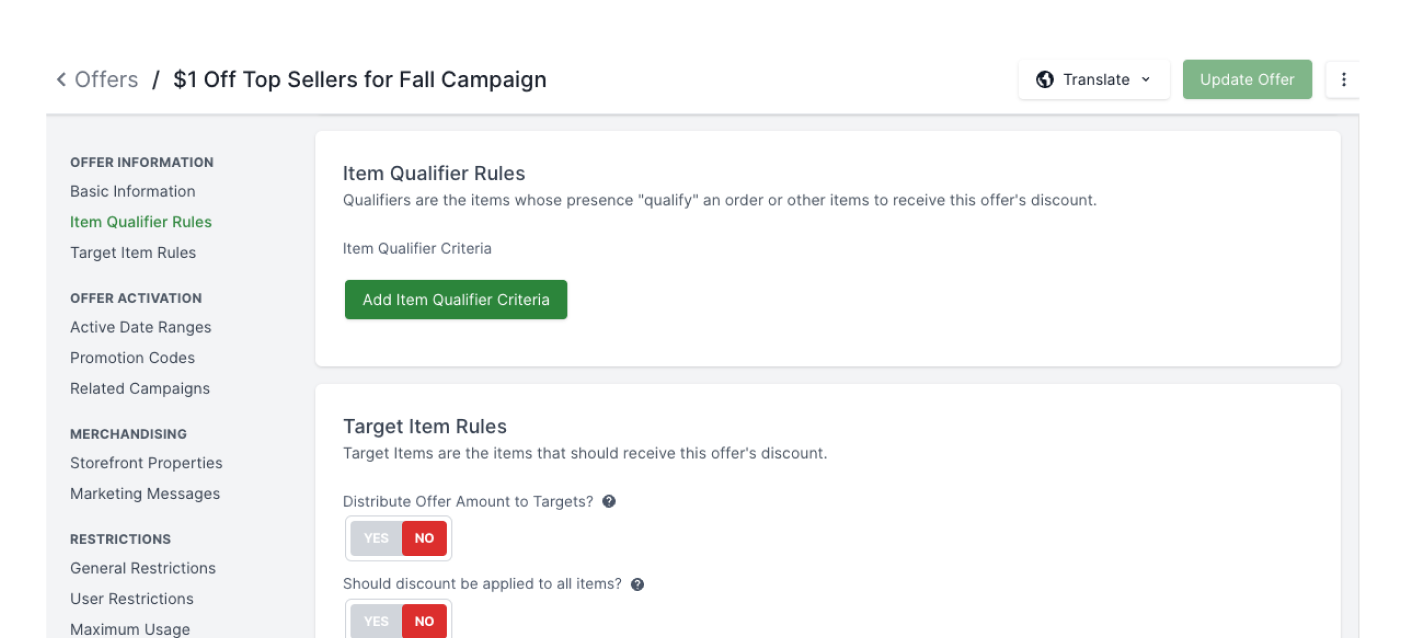How to Build Personalization Right
Written by
Cassandra Gaston
Published on
Oct 14, 2025
In Part 1, we explored why most personalization projects fail: cookie-cutter platforms, integration nightmares, and vendor lock-in. The common thread? Architectures that can't adapt to real business requirements.
So what actually works? How do successful companies build personalization that delivers results without accumulating technical debt or forcing expensive rebuilds?
After working with enterprise retailers, manufacturers, and complex B2B operations, the answer is clear: it starts with the right architectural foundation.
Starting With the Data Model
Effective personalization starts with capturing the right data. Not generic customer profile fields, but the specific data that matters for the business model.
Selling industrial equipment? Facility specs, regulatory requirements, maintenance schedules, procurement workflows. Generic "customer preferences" fields won't cut it. 52% of consumers report higher satisfaction as experiences become more personalized, which means the data driving that personalization needs to be precise.
Running a multi-brand operation? Separate preference tracking for each brand, separate purchase histories, separate loyalty mechanics. Not one combined profile that treats all brands like they're interchangeable.
Broadleaf's domain-driven architecture is extensible by design. Need to track preferred delivery windows? Add the field. Need to segment by equipment compatibility? Build it. Need to capture approval authority levels? Done.
This isn't about having lots of generic fields. It's about having the RIGHT fields for specific business logic. No compromises, no workarounds.
Building Logic That Reflects Reality
Generic recommendation algorithms make generic recommendations. "People who bought this also bought that" works fine for books. It falls apart for complex B2B purchases where buying decisions depend on technical compatibility, regulatory compliance, and long-term service relationships.
The best personalization strategies combine three approaches:
Rule-based personalization for scenarios where the logic is clear. If the customer is in segment X and inventory is below threshold Y, show offer Z. Clear logic, predictable outcomes.
AI-driven personalization for pattern recognition at scale. 73% of business leaders agree that AI will fundamentally reshape personalization strategies. Predict churn risk, forecast next purchase timing, and find behavioral similarities across thousands of customers. Let the algorithms do what they're good at.
Hybrid approaches that surface AI-generated options but apply business rules to ensure recommendations make actual business sense. Research shows that extensive personalization using AI increases average revenue per user by 166%. The AI might suggest a product, but business logic ensures it's compatible with what the customer already owns, is actually in stock, and fits their contract terms.
Separating these concerns into independent microservices means data science teams can iterate on ML models without waiting for IT. Merchandising teams can adjust rules without custom development. Engineers can swap in better tools without rebuilding the stack. Broadleaf's architecture, built on the proven Java and Spring ecosystem, provides the foundation to make this separation practical and maintainable.
Personalizing Beyond the Homepage
Most platforms focus personalization on product recommendations and homepage banners. That's table stakes in 2025.
Real competitive advantage? Personalizing the entire commerce experience. McKinsey research indicates that 65% of customers cite targeted promotions as a top reason to make a purchase.
Pricing that reflects customer segment, order volume, contract terms, competitive position, and inventory levels. Not "20% off for everyone," but intelligent pricing that reflects actual value exchange with each customer. Broadleaf's Pricing Service enables dynamic pricing logic based on these factors without impacting other system performance.
Promotions that consider who the customer is, where they are in their journey, what's in their cart right now, and what business objectives need to be hit this quarter. The Offer Service handles sophisticated promotional rules that can factor in customer segments, cart composition, and business goals simultaneously.
Search results that understand both the explicit query and the implicit context. A returning customer searching "cables" should see different results than a new customer searching the same term, especially with known purchase history that can predict what they're actually looking for. The Search Service integrates seamlessly with customer data to deliver contextually relevant results.
Checkout that shows relevant payment options and shipping methods based on history and preferences. Why show fifteen payment options when only three get used?
Post-purchase experiences with replenishment reminders based on actual usage patterns, service recommendations timed to equipment age and maintenance history, and upsell opportunities that make sense given what was already bought.
The Architecture That Enables This
Here's the uncomfortable truth: sophisticated, adaptable personalization can't be built on a monolithic platform. The architecture won't support it.
This is where Broadleaf's microservices framework fundamentally changes what's possible. When catalog, pricing, promotions, cart, checkout, customer management, and order management are discrete services (over 30 of them) that can be customized, scaled, and deployed independently, everything changes.
Pricing personalization logic doesn't slow down checkout. New recommendation algorithms can be A/B tested without system-wide deployments. Third-party AI tools can be integrated without touching other services. Personalization components can scale based on actual computational demands, not arbitrary platform limits.
But these services can't be siloed. They need to share unified customer data through event streams and APIs. When a customer behavior updates their profile, every service that needs that information gets it in real-time.
Extension Patterns That Matter
The difference between platforms that age well and platforms that force re-platforming comes down to how they handle customization.
Can default behavior be overridden without forking code? Can new personalization logic be added alongside existing functionality? Can data models be extended without breaking upgrades? Can custom microservices be built that integrate seamlessly with core services?
These aren't theoretical questions. They determine whether personalization requirements can evolve without accumulating technical debt that eventually forces a complete rebuild.
Broadleaf was built with the Java and Spring ecosystem specifically because these technologies provide robust, proven patterns for managing change. Developers can override default behavior, extend data models, and add custom business logic, all without touching core code. This means personalization strategies can evolve gracefully as business needs change, without the upgrade-breaking customizations that plague other platforms.
The Open Source Advantage
Commercial open source provides something proprietary platforms fundamentally can't: complete control.
Access to source code means seeing exactly how personalization logic works. Modifying it to match business needs. Deploying wherever makes sense: cloud, on-premises, multi-cloud, whatever.
This isn't philosophical. It's practical:
Regulatory compliance: When regulations require specific data handling, it is implemented exactly as needed. No waiting for vendor interpretation of GDPR or CCPA.
Competitive advantage: Proprietary personalization logic stays proprietary. It's not shared functionality that competitors can also access.
Vendor independence: Never stuck waiting for a vendor to fix critical issues or build critical features.
And with enterprise support, training, and managed services available, it's the control of open source with the reliability of enterprise software.
Real-World Complexity
Simple personalization demos are easy. "Show product recommendations based on browsing history" makes a great conference slide.
Real businesses are messier:
- Multi-brand operations where each brand needs separate catalogs, separate customer profiles, and separate personalization strategies, all managed within one platform instance. Customer data flows between brands when it should (cross-brand loyalty) and stays separate when it must (brand-specific positioning).
- B2B hierarchies where account-level personalization understands corporate structures, buying groups, approval workflows, and contract terms. A junior buyer and the VP of Procurement should see different prices, different products, and different checkout options, even though they're the same account.
- Marketplace models where sellers need to implement their own personalization while maintaining centralized customer intelligence. Balancing seller autonomy with customer experience consistency.
- Subscription complexity where personalization isn't just what to recommend, but what subscription terms to offer, when to suggest upgrades, how to price renewals, and when to intervene to prevent churn.
- Omnichannel orchestration where consistent personalization works across web, mobile, in-store associates, call centers, and connected devices. Not just showing the same content everywhere but adapting appropriately to context while maintaining continuity.
The more complex the commerce model, the more architectural flexibility matters.
A Practical Roadmap
If personalization that drives business results is the goal, here's where to start:
Step 1: Audit What's Actually Being Used
Be brutally honest. What personalization capabilities are being used today? Which ones deliver measurable business value? These are just checkboxes in the platform evaluation that nobody ever implemented properly?
Most companies discover they're using maybe 20% of their platform's personalization features. And even those aren't configured optimally.
Step 2: Define the Actual Vision
Not "what features does the current platform offer" but "what would ideal personalization look like for THIS business?"
What decisions could be personalized that aren't today? What data would be needed? What business logic should govern it? What would scaling this actually require technically?
Step 3: Evaluate the Architecture Honestly
Can the current platform support that vision? Not with six months of custom development, but can it actually support it?
Can the needed data be captured? Can the needed logic be implemented? Can the needed tools be integrated? Can iteration and improvement happen without rebuilding?
If the honest answer is no, there's an architecture problem, not a personalization problem.
Step 4: Start With High-Impact Use Cases
Don't try to personalize everything at once. Identify specific use cases where personalization would drive measurable outcomes:
Reduce cart abandonment for high-value customers. Increase cross-sell rates for specific product categories. Improve conversion for repeat customers with known preferences. Reduce service costs through better self-service recommendations.
Build, measure, learn, iterate. Repeat.
Step 5: Build for Evolution
Choose an architecture that allows graceful evolution instead of forcing painful, expensive rebuilds every few years.
The personalization strategy will change. Customer expectations will evolve. New technologies will emerge. Competitors will raise the bar.
The question isn't whether the strategy needs to change. It will. The question is whether the platform architecture allows evolution or forces expensive rebuilds.
What's Coming Next
We're moving toward a world where AI agents negotiate offers on behalf of customers, where real-time context matters more than historical segments, where privacy regulations require sophisticated consent management, and where customers expect personalized experiences across channels and devices that don't even exist yet.
Marketers now allocate approximately 40% of their budgets to personalization, nearly double what they allocated just two years ago. The platforms that'll enable this future aren't the ones with the most turnkey features today. They're the ones with the architectural flexibility to adapt to whatever comes next.
Personalization isn't a feature that gets purchased off a shelf. It's a capability that gets built. And the foundation matters more than the starting point.
Getting Started
At Broadleaf, we provide the architectural foundation for personalization that works, flexible enough to match unique business models, powerful enough to scale with growth, and open enough to evolve as strategies mature.
If the current platform is limiting what's possible, let's talk about what could be different.




